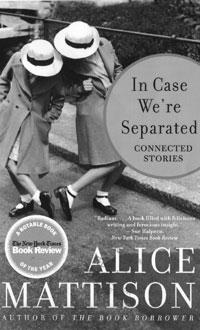Author Alice Mattison read to a full room of faculty and students at the UMass Boston bookstore. Mattison read from her most recently published book “In Case We’re Separated,” a collection of 13 connected short stories. The reading was the first in a series held by UMass Boston’s Creative Writing Program which offers students insight into the techniques, methods, and experiences of published authors.
Mattison’s collection is unusual-it takes its format from the double sestina style of poetry. A sestina is a poem that uses six (usually unrelated) words, which reappear in different order at the end of each line of the poem. At the end of the poem, each of the six words will have appeared after the other five exactly once. Mattison adapted this technique by reusing six different topics in each of her stories, instead of six words.
When asked about her reason for using the sestina format, Mattison responded that “It really wasn’t reasoned, it was always just a given…when I started making notes for this book, the first thing I had was ‘connected short stories’ and the second was ‘based on a sestina.”
“In Case We’re Separated” tells the story of several generations of the Kaplowitz family from the Depression era through the present. Each story revolves around different members of the clan at different times and places.
Mattison, a resident of New Haven, CT, has four collections of short stories, four novels, as well as a volume of poetry to her credit. She grew up in Brooklyn in a family of Jewish immigrants. Although Mattison refers to the book as the “nearest to her own life,” she maintains that it is by no means autobiographical. “I always tried not to do something too close to me because I thought it would be boring, but in this book I decided to write about what was close to me.”
Mattison auditioned several ideas for the six topics before settling on a glass of water, a sharp point, a cord, a mouth, an exchange and a map. Asked why she chose those images, she replied, “I think everybody who writes has experiences where you can’t defend what you do but you just have to do it.”
Originally she told no one about the six recurring images in her collection. “As an author, sometimes you get to have secrets.” She eventually relented, though, because “of course I was proud of myself so I put a note at the end [of the book].”
The story Mattison chose to read was titled “The Bad Jew,” concerning an editor who struggles with her Jewish identity as well as the complexity of human relationships, sex, death and faith. Mattison admits to being scared at times during the writing process and that, despite her accomplishments, “I worry I’m essentially boring and dull. I have no assurance that [what I’m writing] won’t be awful, and often it is for many drafts.”
This is something that is certainly reassuring for any aspiring writer to hear. The title story, which takes place in Brooklyn in the 1950s, was included in Best American Short Stories 2002. Mattison’s other works include: “The Wedding of the Two-Headed Woman” and “Men Giving Money, Women Yelling.” Mattison also co-facilitates a reading series in New Haven, called the “Ordinary Evening Reading Series.” UMB Creative Writing professors Joyce Peseroff and Lloyd Schwartz will read there later in the Spring. For more information about the series, go to http://ordinaryevening.blogspot.com.
For more information about Alice Mattison and her work go to www.harpercollins.com/authors/17615/Alice_Mattison/.





















































